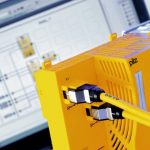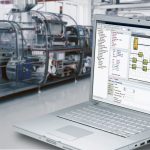Highly networked system structures are emerging with Industry 4.0, involving a wide range of people, IT systems, automation components and machines. Interaction between safety and security and the distribution of control intelligence are essential factors for the success of Industry 4.0.
The automation of the future is safe and smart
When worlds converge
Highly networked system structures are emerging with Industry 4.0, involving a wide range of people, IT systems, automation components and machines. Interaction between safety and security and the distribution of control intelligence are essential factors for the success of Industry 4.0.
The terms Industry 4.0, Internet of Things and Smart Factory describe the increased networking of plant and machinery. Information technology and automation are becoming closely connected. This means that in future, a highly networked industry can increase the value adding potential for customers, while at the same time reducing costs.
Even though Industry 4.0 is considered the fourth industrial revolution, it is in fact an evolution. This is because, for one thing, it presupposes that all parties are willing to change. Moreover, it is not as though many of these technologies have only recently become available or are new to production. Technologies such as RFID and WLAN have already been around for some time. They can be used to record, evaluate and transfer data to a real-time control system during the production process.
The actual challenge is how to combine the two worlds of automation and IT to form practicable solutions. The example of safety shows just how complex this may be: If all communication is decentralised, the demand for secure communication will also rise. This involves safety aspects (machinery safety) and security requirements (operational security) in equal measure.
The field of safety is already characterised by considerable investment security and legal certainty. This is partly due to the need to comply with norms and standards: A safety integrity level (SIL) is defined within IEC standards, enabling globally valid definitions of hazard classes, risk estimations and the verification of achieved safety objectives.
When there is a higher level of networking, the diversity of the various communication relationships within an automation solution will also be higher. Today’s communication systems are increasingly open with a variety of relationships. The issue of security, in other words protecting the machine and its data from unauthorised use, has not yet been adequately resolved. Protecting products and expertise adds another requirement. Common standards need to be developed. Methods for creating safety architectures are called for, along with directives that satisfy the requirements of both safety and security.
Holistic security concepts demand interaction between safety and security, with increasingly tailored system architectures which follow open standards and take account of cross-manufacturer considerations.
Among the key issues here are unique, secure proof of identity for products, processes and machines, including a secure information exchange along the whole production process. In terms of the safety aspect, it is important to check the extent to which security issues influence functional safety.
Even the best security measure is worthless if it is not put into practice, or worse still, is consciously defeated, often due to ignorance and lack of understanding or because it takes too much time. There are analogies here to functional safety. The same applies to both safety and security: The measures which are taken must not compromise the availability of plant and machinery. When it comes to implementation, many processes and experiences from the world of safety can be transferred directly to the world of security.
Important factors for success
Industry 4.0 is driven, for example, by individual customer requirements for products, greater type diversity and declining product life cycles, leading to smaller batch sizes and more frequent reconfiguration of production systems. That is why modularisation and decentralisation are two of the most important factors for success in the Smart Factory. Automation systems that can control the distributed intelligence in a user-friendly way are essential. Plants can then be broken down into manageable, independently functioning units.
The modular structure of plants follows the mechatronic approach. Its philosophy is to consistently merge all the disciplines involved in the machine’s development process: mechanics, electrics and automation technology. The interaction between individual, diverse automation technology components and associated software tools in an automation solution is universally defined. A mechatronic approach demands that even control functionalities should be able to “migrate” into the individual mechatronic modules. Control systems that can support this approach play a key role.
This is where today’s systems reach their limits. On the one hand, although software modules can be created, if they are to be executed by powerful, centralised control systems, commissioning individual modules becomes quite complex. On the other hand, local control systems can be used to automate the modules, but this requires additional effort to establish communications.
Modular and distributable
This explains why automation in the spirit of Industry 4.0 demands solutions that are able to distribute control intelligence and guarantee that the necessary networking of several control systems remains easy for the user to handle. Pilz pursues a consistently modular, distributable approach with the PSS 4000 automation system, which enables the benefits of a decentralised control structure to be reaped without having to accept the increased complexity that normally results when programs are distributed on different control systems. Instead of a centralised control system, the user has access to a user program which is distributed at runtime. During the project configuration phase, however, the user operates the system in a centralised view. All network subscribers are configured, programmed and diagnosed via this centralised project. This permits simplified, standardised handling across the project as a whole. The cost of engineering, commissioning and maintenance can be significantly reduced.
Safety and automation in one system
The central idea behind the PSS 4000 is to merge safety and automation tasks. All process or control data, failsafe data and diagnostic information are exchanged and synchronised between the various automation components via Ethernet. For the control function, therefore, it ultimately makes no difference where the respective program section is processed and where the process data is recorded in the distributed automation system. What makes it so special is that as the process data is valid across the whole system, the mechatronic dividing limits of individual function modules can for the first time be adopted for control and safety tasks in equal measure.
Hall 9, Booth D17
www.cpp-net.com search: cpp0116pilz
Armin Glaser
Armin Glaser
Vice President Product Management, Pilz
Share:








